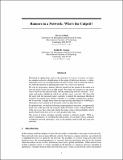| dc.contributor.author | Shah, Devavrat | |
| dc.contributor.author | Zaman, Tauhid R. | |
| dc.date.accessioned | 2014-06-30T13:55:48Z | |
| dc.date.available | 2014-06-30T13:55:48Z | |
| dc.date.issued | 2011-08 | |
| dc.date.submitted | 2011-02 | |
| dc.identifier.issn | 0018-9448 | |
| dc.identifier.issn | 1557-9654 | |
| dc.identifier.uri | http://hdl.handle.net/1721.1/88122 | |
| dc.description.abstract | We provide a systematic study of the problem of finding the source of a rumor in a network. We model rumor spreading in a network with the popular susceptible-infected (SI) model and then construct an estimator for the rumor source. This estimator is based upon a novel topological quantity which we term rumor centrality. We establish that this is a maximum likelihood (ML) estimator for a class of graphs. We find the following surprising threshold phenomenon: on trees which grow faster than a line, the estimator always has nontrivial detection probability, whereas on trees that grow like a line, the detection probability will go to 0 as the network grows. Simulations performed on synthetic networks such as the popular small-world and scale-free networks, and on real networks such as an internet AS network and the U.S. electric power grid network, show that the estimator either finds the source exactly or within a few hops of the true source across different network topologies. We compare rumor centrality to another common network centrality notion known as distance centrality. We prove that on trees, the rumor center and distance center are equivalent, but on general networks, they may differ. Indeed, simulations show that rumor centrality outperforms distance centrality in finding rumor sources in networks which are not tree-like. | en_US |
| dc.description.sponsorship | United States. Air Force Office of Scientific Research. Complex Networks Program | en_US |
| dc.description.sponsorship | National Science Foundation (U.S.). Division of Human and Social Dynamics | en_US |
| dc.description.sponsorship | National Science Foundation (U.S.). Emerging Models and Technologies for Computation Program | en_US |
| dc.description.sponsorship | MIT-Shell Energy Fellowship | en_US |
| dc.language.iso | en_US | |
| dc.publisher | Institute of Electrical and Electronics Engineers (IEEE) | en_US |
| dc.relation.isversionof | http://dx.doi.org/10.1109/TIT.2011.2158885 | en_US |
| dc.rights | Creative Commons Attribution-Noncommercial-Share Alike | en_US |
| dc.rights.uri | http://creativecommons.org/licenses/by-nc-sa/4.0/ | en_US |
| dc.source | Other univ. web domain | en_US |
| dc.title | Rumors in a Network: Who's the Culprit? | en_US |
| dc.type | Article | en_US |
| dc.identifier.citation | Shah, Devavrat, and Tauhid Zaman. “Rumors in a Network: Who’s the Culprit?” IEEE Trans. Inform. Theory 57, no. 8 (n.d.): 5163–5181. | en_US |
| dc.contributor.department | Massachusetts Institute of Technology. Department of Electrical Engineering and Computer Science | en_US |
| dc.contributor.department | Massachusetts Institute of Technology. Laboratory for Information and Decision Systems | en_US |
| dc.contributor.department | Sloan School of Management | en_US |
| dc.contributor.mitauthor | Shah, Devavrat | en_US |
| dc.contributor.mitauthor | Zaman, Tauhid R. | en_US |
| dc.relation.journal | IEEE Transactions on Information Theory | en_US |
| dc.eprint.version | Author's final manuscript | en_US |
| dc.type.uri | http://purl.org/eprint/type/JournalArticle | en_US |
| eprint.status | http://purl.org/eprint/status/PeerReviewed | en_US |
| dspace.orderedauthors | Shah, Devavrat; Zaman, Tauhid | en_US |
| dc.identifier.orcid | https://orcid.org/0000-0003-0737-3259 | |
| dc.identifier.orcid | https://orcid.org/0000-0003-4973-9343 | |
| mit.license | OPEN_ACCESS_POLICY | en_US |
| mit.metadata.status | Complete | |

